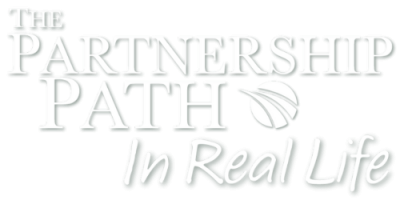Richard Chaves at Microsoft on
Portfolio Management vs Partnership Management
Episode Summary
In this episode of Partnership Path in Real Life, John Rudow sits down with Richard Chaves, a seasoned partnership manager at Microsoft, who has been working with partners throughout his extensive career. They dive into the complexities of managing multiple partnerships and portfolios, sharing invaluable insights on prioritizing tasks, maintaining clarity, and navigating partnerships with ease—even when facing competing priorities. For anyone navigating partner management, this conversation offers practical wisdom and real-life strategies that could transform how you approach your own partnerships.
Transcript
John (00:01)
Well, good morning, Richard. Welcome to the Partnership Path in Real Life. I’m super excited to have you on the podcast today. Can’t wait to get into our topic and talk a little bit. But first, let me give you a chance to introduce yourself to our listening audience. Tell us a little bit about who you are and in particular, how long you’ve been working with partners.
Richard (00:23)
Fantastic to be here, John. Being working with partners. Man, I think that’s probably my entire career. Right now I’m…
John (00:31)
Yeah. So just a couple of years then, right? Because you’re only, you know, you’re in your mid-20s and…
Richard (00:35)
yeah, kind of like last year. I wish so. I’m currently leading a portfolio of partners for the retail consumer goods and telco industries at Microsoft. I’ve been with Microsoft for the last 20 years, so quite a bit of time. I was an entrepreneur before that, so my company was a partner. So a partner of Microsoft. So being working as a partner and with partners for my entire career.
John (00:51)
Okay, just a few.
Yeah. Yeah.
Richard (01:04)
I’d say my background is technical, so I’m a developer by background, but I don’t code for a long time now. When I joined Microsoft back in 2004, I had the opportunity to work in marketing, sales, technical evangelism. Then I moved to United States in 2017 for global sales, which was fantastic. Spent some time in engineering and now officially taking care of partners.
John (01:25)
Nice.
This is why you and I get along so well, Richard, is I actually have an engineering background as well. I’m trained to be a programmer. That’s what I was supposed to do. And I tried it and it was like, yeah, I can’t do this for a living and ended up in sales and partner types of roles. yeah. Wow. It’s funny. All right. So listen, we got you on today to talk about
Richard (01:39)
You see?
That’s all.
John (01:56)
portfolio management versus partnership management. Tony and I just did our episode talking a little bit about some best practices there. And I know you listened to that episode. So let me just start by saying, of all the things that Tony and I talked about, what are the things that kind of got your attention or you disagree with or agree with or whatever? Let’s start there.
Richard (02:19)
Yeah, look, portfolios are complex. Alliances are complexes, right? So when you and Tony discussed it, had the podcast, I would start my take is you emphasize that relationships are complex, right? Those alliances are complexes. We were talking about franchises and how manage business, right? From different perspectives, there’ll be some guidance, but there will be some liberty to do things on the execution day to day, right?
John (02:46)
Yep. Yeah.
Richard (02:49)
When I think about portfolio and partnerships, it’s really, how can we make the most of the business? And if we have clarity on goals, if we have clarity on what to achieve, what’s the value for each part of the alliance, right? And sometimes we may have a partner, let’s say Microsoft working with another partner. We may have a third party, right? A services integrator working with an ISV.
John (02:56)
Yeah.
Yeah. Yeah, yeah.
Richard (03:17)
So could be a multi-party alliance, right? But if we have clarity on each one of the parties we want to achieve, then we can reduce the complexity. Increasing that clarity will say, you know, our lagging indicator success will look like growing revenue. OK, we will see if by the end of the quarter, by the end of the fiscal year, we achieve that. That’s a lagging indicator. What are the leading indicators that we should be managing on a daily basis to make sure that we are on track to deliver that, right?
John (03:46)
Right, right.
Richard (03:46)
So listen to you, Antony, is how to invest time, resources to make sure that we are on track so we can keep the alliance going in the direction that we expect. So the lag indicator, the big result that we are aligned on, we will really deliver. So the complexity, how we manage those partnerships, those probably are the two things that I took from the podcast.
John (04:13)
Yeah, you’ve been doing this a long time, Richard. And one of the things that I know you have experience in that I want to kind of explore with you, especially when you think about either yourself managing a portfolio or managing a group of people who are managing portfolios, is how do you help them allocate the right time on the right partnerships? You know what I mean? The reality is we have too many partners.
to manage, right? We have too much to do. And so, you know, that’s, think, one of the hardest things is to figure out where do I spend my time? Because if I just react to my partners, like, I’ll only get to the first two of them. I’ll never get past that, right? And so what’s your advice for somebody who’s in that challenge right now, trying to figure out how do I choose where to spend my time?
Richard (05:07)
So true, and let’s be honest, it’s not only about the partner driving, maybe the most urgent, not the most important things, could be our company, right? So we need to be aware of the loud voices. And I will back to what I mentioned a few seconds ago about clarity. If we have the right principles in place, we can look back to our principles and say, you know what, this is important. Or, you know what, I can see that there’s active screaming out loud, but this is maybe.
John (05:13)
that right? Yeah, yeah.
Richard (05:36)
urgent, not necessarily important. And I remember I was in the Microsoft office, I believe it was Singapore, and I saw that mug in the cafeteria, in the kitchen. It said, we all had 24 hours. We need to choose wisely how we spend time and energy. So my guidance to my team is, and that’s how I challenge them and challenge myself.
John (05:52)
Yeah. That’s right. That’s right. Yeah.
Richard (06:05)
Are we being true to our principles? Do we have that clarity on, again, lagging indicators, leading indicators? Are we on track? And what makes this challenging, John, is everyone will face some, in some point in time, challenges that are not expected. Could be a technical outage, right? And then it’s urgent, right? We need to fix that and everything else will be…
John (06:27)
Right, sure. Yep, yep.
Richard (06:35)
second, third priority. And that’s the right thing to do. Sometimes it’s an economic challenge. Sometimes it’s a business change. Our partners, the companies that we work with, they may be planning for IPO. So, okay, is that a moment for cost reduction, efficiency? Or do you need to innovate to show something to the market? If we have this clarity, when we build the Alliance, there is a reason we are building that.
John (06:58)
Yeah. Yeah.
Richard (07:05)
specific alliance, right? We do believe that working together will grow faster. Because if there is no clarity about that, we should not be working together, right? So if that principle, okay, we are getting together because we will grow faster. How we do that? And things can really turn into bright complex situations. I have several situations where my partners are also competitors in some aspects of the business.
John (07:11)
Yeah. Yeah.
Yeah.
Richard (07:34)
Right? So the executive can come to me and be really out loud on some specific part of the partnership that, you know what, we agree that we are not touching on that. Are sure we want to invest energy. We’re not probably solving that. Should it be investing time and energy on the things that will drive growth? Because that’s the reason why we’ll be the partnership. So when I think about the work I do with my team is really challenging.
Because in the heat of the moment, would be hard to say no. But I’d say ruthless prioritization. think a lot of people talk about that. But also ruthless clarity. If we have this moment that we shake hands, we look people in the eyes and say, that’s what we are here for. When that moment came and people just throw all things that we need to do this now, let’s pause, take a breath, look back to our principles.
John (08:15)
Yeah.
Yeah. Yeah.
Richard (08:30)
I’m sure we are revising our principles. Why are we changing direction now?
John (08:35)
Yeah, yeah, I love that. And it’s such a critical mindset that we help partner managers do that, not only on a partner by partner basis or a partnership by partnership basis, but then within their own portfolio, That, look, yes, you work with this group of partners, but you also have to have that clarity.
and that ruthless prioritization when you’re choosing one partner over another for the limited time that you have, right? Of what’s my overall objective? How clear am I on that? And how does this collection of partners help me get there? And I think that’s really hard for a lot of channel-oriented people to do because we care a lot about the partners, right? And so…
You know, we feel bad sometimes when we can’t give everything to the party.
Richard (09:35)
So true. And I also bring this responsibility for me as a manager, right? Because we can be the one causing the confusion. We can be the one increasing the volume. And look, sometimes it’s required. Sometimes we need to do that. The way I earn trust from my partners, the way I work with my team to earn their trust as well is if there’s something that we are changing the approach, let me tell you the reason why, right? And I’d be, you know.
John (09:40)
Yeah.
For sure, yeah.
Yeah. Yeah.
Richard (10:04)
We were not supposed to do that, but that’s an exception. Let me tell you why it’s important now. That’s how it will be helping and supporting our strategy long-term. again, if we have this clarity on the better together story, why we’re building this Alliance, that will help us to prioritize. And I think that that’s critical on how we work with partners and our teams. But again, we all have 24 hours we need to prioritize.
John (10:26)
Yeah. Yeah.
Yeah, I love that. I can’t remember what the math is. We used to do, I used to use that in these classroom training sessions I used to do with salespeople sometimes where we would write, I think the number is 768 maybe, which is the number of hours that we have in a month. And like everyone has the same, like, so you’ve got the same as your, as the guy next to you, as your competitor, as everybody else, right? And the question is, is how well do you use that time?
Richard (10:47)
Interesting.
John (11:00)
Right? Because it’s the great equalizer. Everyone has the same. And so the ones who are really good at what they do are the ones who use their time the best. Right? So I want to get your opinion. This is something I’ve been dying to ask you for a while, which is, we talk, and Tony and I mentioned this in the episode, about what we call run rate. And what we mean by that is how much of the business is going to happen, whether you show up or not.
Richard (11:08)
100%.
John (11:27)
And so I just want to get your take on it, especially as a manager over, over some PDMs, right? Like, how do you help a PDM sort of come to terms with how much is going to happen, whether I show up or not so that they focus on the right stuff.
Richard (11:43)
Yeah, that was a good one, a good discussion, you and Tony. And I’m smiling because that’s a recurring, I may say tough topic with my team, right? Look, we are always super proud of the work we do. Let’s assume people work a lot and super dedicated to the Alliance. To your point, we want to do the best for the partner. We are the license of that partner, the company side, our company.
John (11:54)
Yeah. Yeah.
Richard (12:15)
I always emphasize and again, increasing clarity, make sure that people understand how we run the business, right? And that’s something that I repeat. I believe repetition is our friend. Let’s separate and break down effort from results. That’s number one. I can work 24 hours, have no sleep, no family, no personal life, do a lot of stuff. And by the end of the week, the month, the year,
John (12:32)
Yep. Yeah. Yep.
Richard (12:45)
Numbers are not good. Impact is not there. So first of all, let’s separate effort from impact. For me personally, it gives me clarity on, OK, let me prioritize effort here because I know that here I can drive impact and results. I will not prioritize this because it would be a lot of work, no results. That’s number one. Number two is attribution.
John (12:53)
Yep.
Yeah, right.
Richard (13:14)
I have a routine habit to have one-on-ones with every member of my team weekly. Then we have our monthly reviews, then we have our quarterly checkpoints and fiscal year performance review. On those moments, I constantly ask, what can I attribute to you? You know what? Market economy will go up, your partner will benefit from that.
John (13:37)
Mmm.
Richard (13:42)
Markets may go down when you face challenges, right? I cannot attribute that to you, not for the good, not for the bad. On the things like, hey, we grew 20%. Awesome. Fantastic. Good alignment to our goals. What can I attribute to you?
John (13:44)
Yeah. Right. Yeah.
Yeah, what did you do? What was your real impact on that?
Richard (14:02)
And then it’s a great opportunity to tell a story about that was the effort. Those are the results. I can attribute that to me. I have, I open a new connection. I got a better relationship with some specific stakeholder. We decided to grow in a geography that we are not in. We created a new product and we launched that product to the market. I can attribute that. And that could be internally, I find the right people inside.
John (14:09)
Yeah. Yeah.
Yeah, yeah.
Richard (14:30)
Let’s say Microsoft to help the partner. Could it be externally with a partner? Could it be a partner to partner relationship that we foster? So attribution is key.
John (14:32)
Sure. Right.
Yeah. Yeah.
Yeah, look, I love that. So that’s classic Richard for me, right? Like you’re able to just kind of distill that down into something super simple, which is I love that because that’s what we try and do. Look, Richard, we, as you know, we try and keep these episodes pretty short so that people have a quick listen on their way into the office or whatever, get a few practical tips. So let’s close on this. Given this this stuff we’ve talked about, right, this this
focus on clarity and the radical prioritization or ruthless prioritization and this whole idea of attribution. Love all three of those. Is there anything else you would kind of give as one last pointer to somebody who’s out there managing too many partners and just trying to navigate their way? Any last words of advice, kind of a last nugget you want to give?
I really, I put you on the spot, didn’t I?
Richard (15:42)
Now I’m taking a pause here because there are so many things we can explore. Not sure if that’s the most important, but one that I really believe is critical for the execution is as a leader managing a team of partner managers, right?
John (15:47)
Yeah.
Richard (16:04)
My principle is to not get into the way of my team to drive results. I cannot increase complexity. cannot, I need to unblock them and I need to support them to drive and deliver more results. One of the things that I should not do is to increase complexity on internal tasks or randomize them. Hey, this month we are looking about
John (16:13)
Right, Yeah.
Right? Yeah.
Richard (16:30)
how many products we are creating. Let’s talk about technical. Next month, I’ll talk about marketing and how we go to market the events, the man generation. Next month about sales. To be fair, we need to do the three of those. How can I simplify and say constantly, I will always check our pipeline of products that we are developing together. As soon as we develop those products, how I promote those products to them, or how we go to market with a partner.
John (16:34)
Yeah. Yeah. Yep.
Richard (16:58)
And if we do one and two correct, that will drive sales. So that’s our story. It’s an attribution story. I can connect the dots. But I will simplify in three buckets what’s important for me and how I will manage their performance. I think it’s, I would mention that, John, it’s about simplifying. It’s about increasing class so people know what to expect so they can do their job.
John (17:01)
Yep. Yep.
Yeah. Look, you know what I love the most about that, Richard, is you took that from an approach of a manager managing some partner managers. I would argue that the same is true for those partner managers with their partners, right? They can follow those same principles, which is part of our job is to simplify the relationship and what we’re trying to do together and stick with the clarity and ruthlessly prioritize together.
All of that applies one-on-one as well, I think, with partnerships. Excellent. Richard, thank you so much for coming on the podcast. I really appreciate it. Love your perspective. And you talked about a couple of things today that make me want to have you come back, one of which was you kind of dangled on multi-party partnerships. And I may have you come back for that later this season. Yeah. Thanks a lot, Richard.
Richard (17:58)
I like that and I talked to my team about that. That’s a good one, Thank you for that.
It will be a pleasure. Great to be here. Thanks, John. Take care.
Key Takeaways
- Prioritization Is Key: Richard emphasizes the importance of “ruthless prioritization” in partner management to avoid distractions and focus on impactful activities.
- Clarity Drives Success: Establishing clear goals and principles helps align partners and reduces complexity in decision-making.
- Effort vs. Impact: Separate the effort put in from the actual impact achieved. Time management, clear goals, and alignment with overarching objectives are essential.



